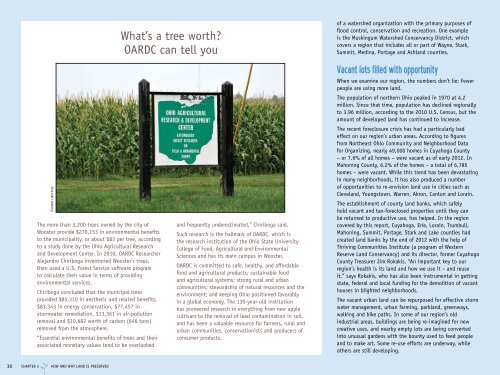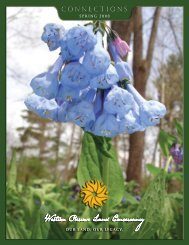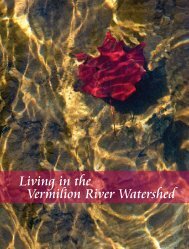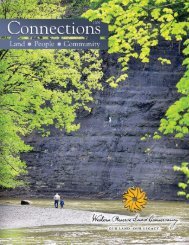Common Ground - Western Reserve Land Conservancy
Common Ground - Western Reserve Land Conservancy
Common Ground - Western Reserve Land Conservancy
You also want an ePaper? Increase the reach of your titles
YUMPU automatically turns print PDFs into web optimized ePapers that Google loves.
© DAVID LIAM KYLE<br />
The more than 3,200 trees owned by the city of<br />
Wooster provide $270,153 in environmental benefits<br />
to the municipality, or about $83 per tree, according<br />
to a study done by the Ohio Agricultural Research<br />
and Development Center. In 2010, OARDC Researcher<br />
Alejandro Chiriboga inventoried Wooster’s trees,<br />
then used a U.S. Forest Service software program<br />
to calculate their value in terms of providing<br />
environmental services.<br />
Chiriboga concluded that the municipal trees<br />
provided $85,310 in aesthetic and related benefits,<br />
$83,343 in energy conservation, $77,457 in<br />
stormwater remediation, $13,361 in air-pollution<br />
removal and $10,682 worth of carbon (646 tons)<br />
removed from the atmosphere.<br />
“Essential environmental benefits of trees and their<br />
associated monetary values tend to be overlooked<br />
30 CHAPTER 3 HOW AND WHY LAND IS PRESERVED<br />
What’s a tree worth?<br />
OARDC can tell you<br />
and frequently underestimated,” Chiriboga said.<br />
Such research is the hallmark of OARDC, which is<br />
the research institution of the Ohio State University<br />
College of Food, Agricultural and Environmental<br />
Sciences and has its main campus in Wooster.<br />
OARDC is committed to safe, healthy, and affordable<br />
food and agricultural products; sustainable food<br />
and agricultural systems; strong rural and urban<br />
communities; stewardship of natural resources and the<br />
environment; and keeping Ohio positioned favorably<br />
in a global economy. The 130-year-old institution<br />
has pioneered research in everything from new apple<br />
cultivars to the removal of lead contamination in soil,<br />
and has been a valuable resource for farmers, rural and<br />
urban communities, conservationists and producers of<br />
consumer products.<br />
of a watershed organization with the primary purposes of<br />
flood control, conservation and recreation. One example<br />
is the Muskingum Watershed <strong>Conservancy</strong> District, which<br />
covers a region that includes all or part of Wayne, Stark,<br />
Summit, Medina, Portage and Ashland counties.<br />
Vacant lots filled with opportunity<br />
When we examine our region, the numbers don’t lie: Fewer<br />
people are using more land.<br />
The population of northern Ohio peaked in 1970 at 4.2<br />
million. Since that time, population has declined regionally<br />
to 3.96 million, according to the 2010 U.S. Census, but the<br />
amount of developed land has continued to increase.<br />
The recent foreclosure crisis has had a particularly bad<br />
effect on our region’s urban areas. According to figures<br />
from Northeast Ohio Community and Neighborhood Data<br />
for Organizing, nearly 49,000 homes in Cuyahoga County<br />
– or 7.6% of all homes – were vacant as of early 2012. In<br />
Mahoning County, 6.2% of the homes – a total of 6,785<br />
homes – were vacant. While this trend has been devastating<br />
in many neighborhoods, it has also produced a number<br />
of opportunities to re-envision land use in cities such as<br />
Cleveland, Youngstown, Warren, Akron, Canton and Lorain.<br />
The establishment of county land banks, which safely<br />
hold vacant and tax-foreclosed properties until they can<br />
be returned to productive use, has helped. In the region<br />
covered by this report, Cuyahoga, Erie, Lorain, Trumbull,<br />
Mahoning, Summit, Portage, Stark and Lake counties had<br />
created land banks by the end of 2012 with the help of<br />
Thriving Communities Institute (a program of <strong>Western</strong><br />
<strong>Reserve</strong> <strong>Land</strong> <strong>Conservancy</strong>) and its director, former Cuyahoga<br />
County Treasurer Jim Rokakis. “An important key to our<br />
region’s health is its land and how we use it – and reuse<br />
it,” says Rokakis, who has also been instrumental in getting<br />
state, federal and local funding for the demolition of vacant<br />
houses in blighted neighborhoods.<br />
The vacant urban land can be repurposed for effective storm<br />
water management, urban farming, parkland, greenways,<br />
walking and bike paths. In some of our region’s old<br />
industrial areas, buildings are being re-imagined for new<br />
creative uses, and nearby empty lots are being converted<br />
into unusual gardens with the bounty used to feed people<br />
and to make art. Some re-use efforts are underway, while<br />
others are still developing.









